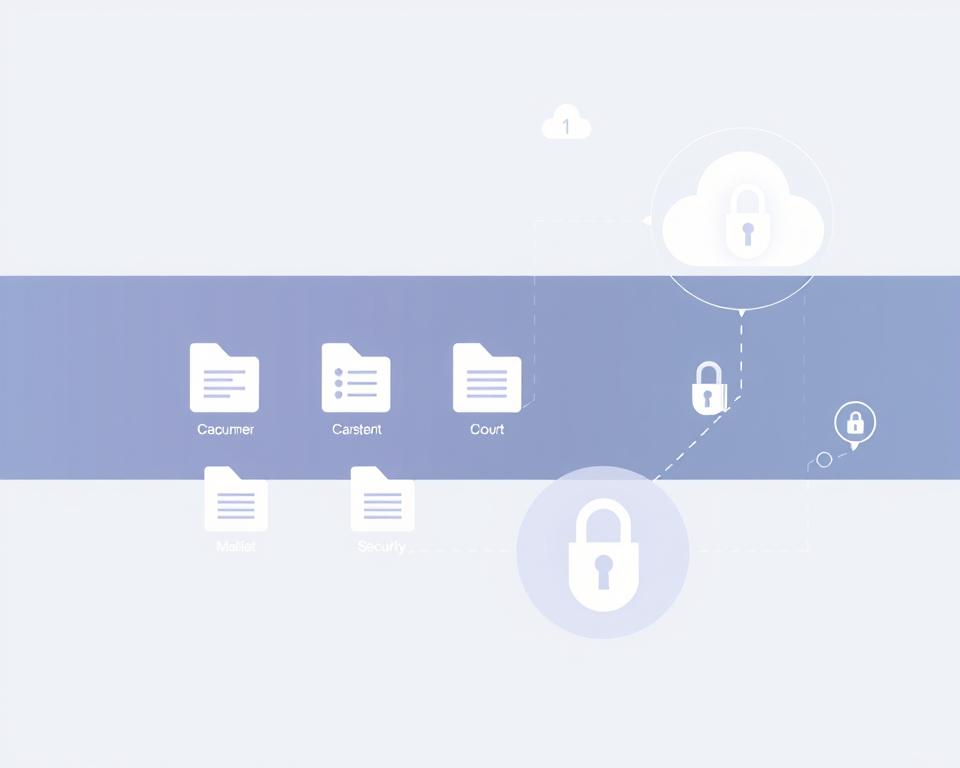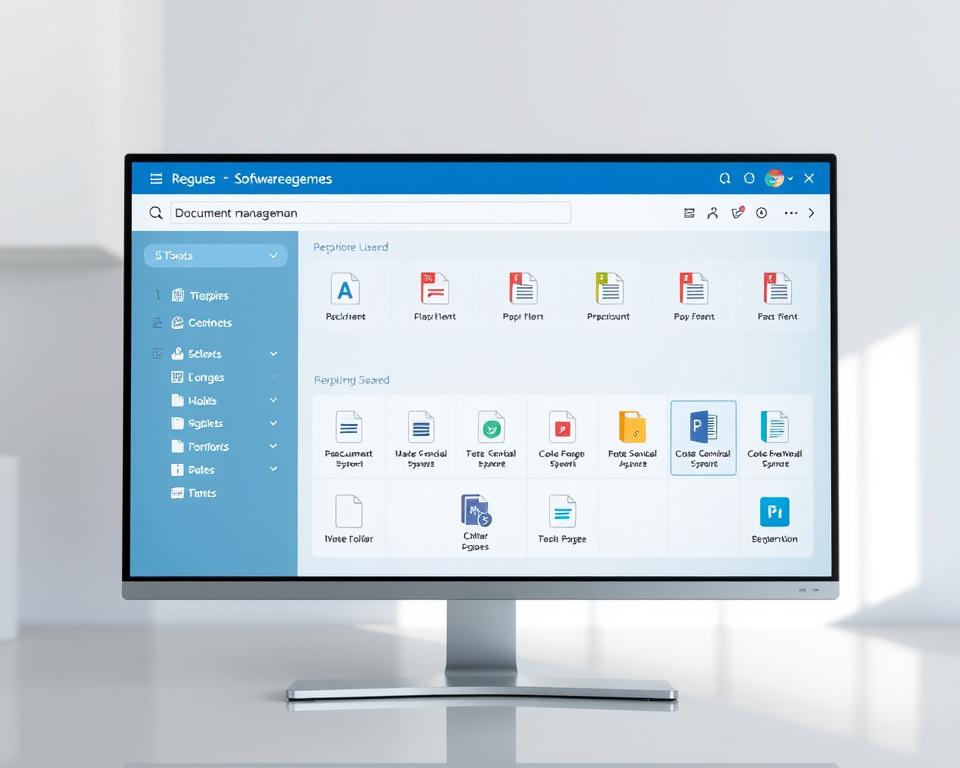I’ve been drowning in a sea of digital clutter lately. My computer’s desktop looks like a virtual tornado hit it, with files scattered everywhere. It’s frustrating and time-consuming to find what I need. That’s when I realized I needed a better solution for document management and electronic document storage.
Document management software has become a lifesaver for many, offering a central hub for storing, managing, and accessing documents electronically1. As I delved deeper into the world of digital file organization, I discovered some fascinating options that could potentially transform my workflow.
For instance, M-Files caught my eye with its automated workflows for regular document processes, seamlessly integrating with Office 3651. On the other hand, Fluix stood out for its offline mode, perfect for those times when I’m working remotely without internet access1.
I was intrigued to learn that worldwide revenue projections for document management systems are steadily increasing2. This growth shows I’m not alone in my quest for better file management. With options like Microsoft SharePoint Online and Rubex by eFileCabinet offering robust features and high user ratings, I’m excited to explore how these tools can help me streamline my document storage and boost my productivity2.
Introduction to File Management Software
File management software is changing how we organize digital documents. As more businesses go paperless, these tools are key for better operations and productivity.
What is File Management Software?
File management software makes it easy to organize, store, and find electronic documents. It’s a digital alternative to paper systems, making work more efficient. There are three main types: hierarchical, network, and relational, each for different needs3.
These systems have features like document routing and PDF scanning. They also help keep your digital space organized and secure4.
Why I Need It for My Documents
Using file management software has many advantages. It makes organizing easier, improves teamwork, and keeps data safe – all important for today’s businesses5. It lets me share files in real-time and access them from anywhere.
Good file management, like using a clear hierarchy and labels, has made my work better5. With these strategies and a solid file management system, I’ve made my digital space more efficient and productive.
Features to Look for in File Management Software
When I look for file management software, I focus on key features. These features boost productivity and streamline my workflow. Let’s explore what makes a top-notch system stand out.
User-Friendly Interface
A clean, intuitive interface is crucial. I need software that’s easy to navigate on both desktop and mobile devices. This ensures I can manage files efficiently, regardless of where I’m working.
With 83% of office workers wanting to work from home at least once a week, a user-friendly mobile interface is non-negotiable6.
Advanced Search Capabilities
Powerful search functions are vital for document retrieval. Did you know that 57% of employees spend nearly half their work hours searching for information7? That’s why I prioritize software with robust search capabilities.
Integration with Other Tools
Seamless integration with existing business tools is essential for workflow automation. I look for software that offers cloud storage integration and can import from other storage solutions. This flexibility is crucial, as organizations typically use four different repositories to store and manage documents6.
Other features I consider include:
- File permissions for access control
- In-system communication tools
- Automated organization features
By choosing software with these features, I can avoid the pitfalls of poor document management. Remember, 3% of enterprise documents get misfiled, potentially leading to substantial consequences7. The right file management software helps prevent such issues and keeps my work organized and efficient.
Benefits of Using File Management Software
I’ve found that file management software is a game-changer for keeping documents organized. It changes how I manage my files for the better.
Improved Organization
Managing files is easy with the right software. I can sort documents and keep related files together. This makes finding what I need quick and simple8.
The software also helps by automatically filing and tagging documents. This saves me time and cuts down on the stress of losing files.

Enhanced Security for My Files
Keeping documents safe is crucial, and this software does it well. It has features like access control and audit trails to protect sensitive info9. Plus, it offers password protection and encryption to keep data safe from unauthorized access.
Accessibility Anywhere, Anytime
Being able to access files from anywhere is a big plus. Cloud-based solutions let me get to my documents from any location. This is super helpful for working remotely.
Other benefits include:
- Version control to avoid confusion about document updates8
- Automated workflows for better efficiency9
- Easy collaboration with features like threaded discussions and comments8
- Less email clutter by keeping important documents in one place8
Using a strong file management system has greatly improved my work. It’s a must-have for anyone wanting to make their digital space more efficient.
Popular File Management Software Options
I’ve looked into many file management tools to find the top ones for easy document storage. Cloud storage is now very popular. It makes sharing files and editing them together easy.
Google Drive
Google Drive is my favorite for cloud storage. It works well with other Google tools, making it easy to share and edit files together. I like how you can work on documents, spreadsheets, and presentations in real time.
Dropbox
Dropbox is also a great choice for cloud storage. It’s easy to use and syncs files well, perfect for both personal and work needs. Its file sharing is great for team projects.
Microsoft OneDrive
If you use Microsoft Office, OneDrive is perfect. It integrates well with Office apps, making it easy to share and edit files. I like its big storage and strong security.
There are other good options too. M-Files, for example, offers cloud storage from 250GB to 1000GB, with custom plans10. DocuWare focuses on creating a digital workplace for document management11.
When picking file management software, I look at storage, ease of use, and how well it integrates. Revver (formerly eFileCabinet) has storage from 32GB to 4TB, which is great for documents10. It’s smart to try out different tools to find what works best for you.
Comparing Cloud-Based vs. On-Premises Solutions
I have to choose between cloud-based and on-premises solutions for file management. Each has its own benefits and drawbacks. These affect data security, scalability, and IT infrastructure.
Pros and Cons of Cloud-Based Software
Cloud-based solutions are flexible and cost-effective. I can access my files from anywhere. The pay-as-you-go model lets me scale resources as needed12. I don’t have to manage infrastructure or pay for hardware upfront13.
However, cloud performance can change with internet speed. I rely on the provider’s policies, which might cause vendor lock-in13. Security is also a worry, as cloud data breaches are a threat12.
Benefits of On-Premises Storage
On-premises solutions give me control over my data and IT. I can customize hardware and software for my needs. This ensures fast data access for big tasks13. For sensitive data, on-premises storage offers better security with air-gapped protection13.
The big downsides are the high initial and ongoing costs. On-premises systems need IT skills for setup and upkeep, which can be hard and time-consuming13. But, they don’t need internet to access data, which can save on monthly internet costs14.
In the end, my choice depends on my needs, budget, and how sensitive my data is. A hybrid solution might be the best. It combines the best of cloud and on-premises storage for great file management.
How File Management Software Can Save Time
File management software has changed the game for productivity. It makes storing and finding documents much faster. This saves a lot of time, especially since employees spend about 20% of their work hours searching for data15.
Efficient File Retrieval
File management systems have made finding documents a breeze. I can find files in seconds, no matter where they are. This saves a lot of time, with companies saving up to $40,000 a year15.
Automation is another big time-saver. I can automate tasks like creating and editing files. This lets me work on many files at once, making me more productive16.
Simplified Collaboration with Others
Sharing documents is easy with file management software. I can share and work on files with my team instantly. Version control keeps track of changes, avoiding confusion and extra work15.
Cloud-based systems have made my files accessible from anywhere15. This is key for working remotely. With features like unlimited live copies of files, I never lose access to important documents16.
The Importance of File Security and Backup
File security is key to keeping my personal info safe. With cyberattacks on businesses up 27% last year, I must stay vigilant17. It’s crucial to have strong data protection, especially since over 50% of employees use personal devices on unsecured networks17.
Protecting My Sensitive Information
To keep my data safe, I look for software with top-notch cybersecurity. This includes encryption and access controls. I also make sure to update my anti-virus and firewall software regularly18. For secure data transfers, I use encryption18.
Setting Up Automatic Backups
Automatic backups are essential for disaster recovery. They ensure I don’t lose any files and backups happen without fail18. Data loss can cost small businesses $400 per hour and large companies $9,000 or more19.
I choose cloud storage for its ease but watch out for costs for big data19. For Windows, I use Backup and Restore, and on Mac, Time Machine18. These tools help me keep secure copies of my files, giving me peace of mind.
Tips for Choosing the Right Software for Me
Finding the right file management software can be hard. I need to think about what I need now and what I might need later. Let’s look at some important things to consider when picking software.
Assessing My Storage Needs
First, I’ll figure out how much storage I need. I’ll count my files and guess how much space they’ll take up. I’ll also think about the kinds of documents I use most.
Some software, like Google Drive, offers free storage. Others charge different amounts20. It’s important to pick software that’s easy to use.
Almost half of people find their company’s online filing confusing. So, it’s important to choose software that’s easy to use21. I’ll look for software with simple interfaces and useful features like advanced search.
Considering Future Growth
Thinking about how my needs might change in the future is key. The global document management system market is expected to grow a lot, reaching $24.91 billion by 203222. This shows how important these systems are becoming.
I’ll look for software that can grow with me. Some options, like ClickUp, have different pricing tiers for different users22. It’s also good to read software reviews on sites like G2 and Capterra to learn more about file management and user experiences.
By carefully thinking about my needs and future growth, I can find file management software that will make my document storage easier and help me work better.
Real User Experiences and Testimonials
I looked into customer reviews to see how file management software helps businesses. Users share how it makes a big difference in their work.
Success Stories from Other Users
Many companies say they’ve seen big improvements after using file management tools. For example, M-Files users found their adoption rate went up by 25%. They also cut their document search time by 40%23.
DocuWare users saw their document processing speed jump by 35%. They also saved up to 20% on costs23.

In the legal world, firms like Nadrich and Cohen loved AI for quick data capture. Real estate agencies also benefited, with Treasure Coast MLS Search using automatic file sorting. This cut down manual work and made documents easier to find.
Lessons Learned from Using File Management Software
Choosing the right software is key, users say. Revver (formerly eFileCabinet) got high marks (9.7/10) for its automation and storage24. M-Files was praised (9.4/10) for being easy to use and automated24. DocuWare was noted for its wide range of integrations, linking to over 500 apps24.
Across different industries, having one place for all important documents helps a lot. It makes teamwork better, keeps things organized, and saves time25. The main lesson is that the right software can save a lot of time and money. This boosts productivity and makes users happier.
Conclusion and Final Thoughts
Exploring file management software has shown me its huge impact on business efficiency. The right tools can change how we manage digital files, saving time and money.
My Personal Recommendation
Choosing the best software depends on your needs. For small businesses, cloud-based options like Google Drive or Dropbox are great. They help find files fast, saving up to 9 hours a week26.
Big companies with complex needs might prefer advanced systems like M-Files or DocuWare. These offer strong features for automating tasks and improving workflow27.
Encouragement to Explore Options
Try free trials and demos to find the best fit for your business. Good file management software can greatly improve search, up to 270% better26. With cloud computing, mobile access, and AI on the rise, a strong system now will prepare you for the future28.
By choosing the right document management solution, you’re not just organizing files. You’re investing in your company’s productivity and success.
FAQ
What exactly is file management software?
Why do I need file management software for my business?
What key features should I look for in file management software?
How does file management software improve organization?
What are some popular file management software options?
Should I choose a cloud-based or on-premises solution?
How can file management software save me time?
How important is file security in management software?
What should I consider when choosing file management software?
Are there any real user experiences I can learn from?
What’s the best file management software for my business?
Source Links
- https://zapier.com/blog/best-document-management-software/ – The 19 best document management software systems in 2024
- https://www.pcmag.com/picks/the-best-document-management-software – The Best Document Management Software
- https://www.canto.com/glossary/file-management/ – File Management: A Comprehensive Guide
- https://www.hellobonsai.com/blog/file-management – Understanding file management: Tips, tools, and basic definitions
- https://www.docupile.com/what-is-a-file-management-system/ – Decoding the Essence of a File Management System
- https://monday.com/blog/project-management/file-management-software/ – What is file management software? 6 must-have features
- https://www.filecenter.com/blog/document-management-software-features/ – 10 Main Features of a Document Management Software for Enterprises in 2024
- https://nordlocker.com/blog/file-management/ – Why is file management important?
- https://www.softlist.io/benefits-of-file-management-system/ – Benefits Of File Management System You SHould Know
- https://www.business.com/categories/document-management-software/ – Best Document Management Software Reviews of 2024
- https://www.techradar.com/best/best-document-management-software – Best document management software of 2024
- https://www.cleo.com/blog/knowledge-base-on-premise-vs-cloud – On Premise vs. Cloud: Key Differences, Benefits and Risks
- https://editshare.com/post/cloud-vs-on-premise-video-storage-solutions/ – Pros and cons of cloud vs on-premise video storage solutions
- https://morefield.com/blog/on-premises-vs-cloud/ – On-Premise vs. Cloud Pros and Cons | Which is Better?
- https://www.hyland.com/en/resources/terminology/document-management/file-management-software – File Management and File Management Systems 101 | Hyland
- https://www.logicaldoc.es/blog/548-what-exactly-is-file-management-software – What exactly is file management software, and why do you need it in the first place? – LogicalDOC
- https://winzip.com/blog/enterprise/secure-enterprise-file-storage-benefits/?srsltid=AfmBOorB6GJecC2ucTwaYCV1Bxtb8fvA1fHEt8cDEdfTm23Ko4PTbfxj – Top 5 Benefits of Secure Enterprise File Storage
- https://www.usgs.gov/data-management/backup-secure – Backup & Secure | U.S. Geological Survey
- https://www.fbponline.com/news/data-backup-importance-options-and-storage-technologies/ – Data Backup: What Is It, Its Importance & Storage Options
- https://www.thryv.com/blog/best-document-management-software/ – The 10 Best Document Management Software for Small Business
- https://blog.mesltd.ca/document-management-vs.-file-management-which-system-is-right-for-your-business – Document Management vs. File Management: Which System is Right for Your Business?
- https://clickup.com/blog/enterprise-document-management-software/ – 10 Best Enterprise Document Management Software | ClickUp
- https://www.compliancequest.com/document-management/software/ – Document Management Software
- https://www.businessnewsdaily.com/8038-best-document-management-software.html – The Best Document Management Software of 2024- businessnewsdaily.com
- https://www.docupile.com/ – Docupile Home
- https://blog.pics.io/what-is-file-management-system-and-why-do-you-need-one/ – What is File Management System and Why Do You Need It?
- https://www.smartsuite.com/blog/document-management-vital-business – Why Good Document Management is Vital for Your Business
- https://filecamp.com/blog/the-future-of-file-management/ – The Future of File Management is Coming… are you prepared?
